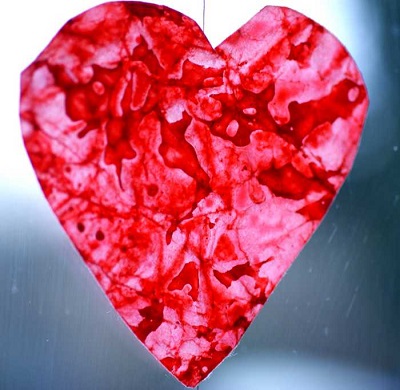FWP:
For background see S. R. Faruqi's choices. For more on Ghalib's unpublished verses, see the discussion in {4,8x}. This verse is from a different, unpublished, formally identical ghazal,, and is included for comparison. On the presentation of verses from unpublished ghazals like this one along with formally identical divan ghazals, see {145,5x}.
The black spot at the center of the heart is called the 'suvaida'; I have made it an English word, for want of a better. Here it shows another side of its versatile nature: it can be melted down into the blackest of black paint. For more on its general qualities, and other examples of its use, see {3,2}.
In general, the color of the wound in the heart is (what else?) blood-red, so that its related imagery comes from the domain of red roses and red wine and red fire (and even the red sun, as in the wonderful {62,8}). If all that brilliant, flowing redness is overlaid on the deepest black, perhaps they won't really create overtones of some kind of purple; that doesn't seem like the right outcome. Instead, perhaps the black under-coat at the heart's core will remain separate, anchoring, grounding, sustaining the radiant red of the heart's blood. It will be a contrast in the color sense, but not of course in the emotional sense. (For the very few other examples of verses about drawing or painting, see {6,1}.)
According to Zamin, such an under-coat will ensure the ill-fortune of the longing itself. According to Gyan Chand, it will enable us to guess how dark this particular heart-wound itself must be.
But it's hard to get very far with the imagery, because it remains not only hyper-abstract but also inert; the verse doesn't really do anything coherent with it.

Zamin:
niyāz = An offering, although this word is used to mean 'need' when paired with naz . But both are current in the common idiom with the meaning of 'offering'. tah-bandī = This is an idiom of the English. Before applying the real color they put a lightish layer/'dip'; this color is called tah-bandī .
He says that the melting of the heart became an offering to the ebullition of longing/grief-- that is, it became useful to the ebullition of longing/grief, since it melted the heart. And when it caused even the suvaida to melt, and from the melting of both a black color became available, then with it the under-coat of the cloak/veil of tamannā was put in place. In this way tamannā was dipped in a pot of blue-black, and colored with the color of ill-fortune. And all this was done by the hand of longing/grief. That is, ḥasrat was the giver of ill-fortune to tamannā .
== Zamin, pp. 360-361